Welcome to my article on B2B segmentation. In today’s business world, targeting the right audience is crucial for success. Total Addressable Market (TAM) is an effective way to identify potential customers with similar characteristics, and B2B market segmentation is the method to help with it.
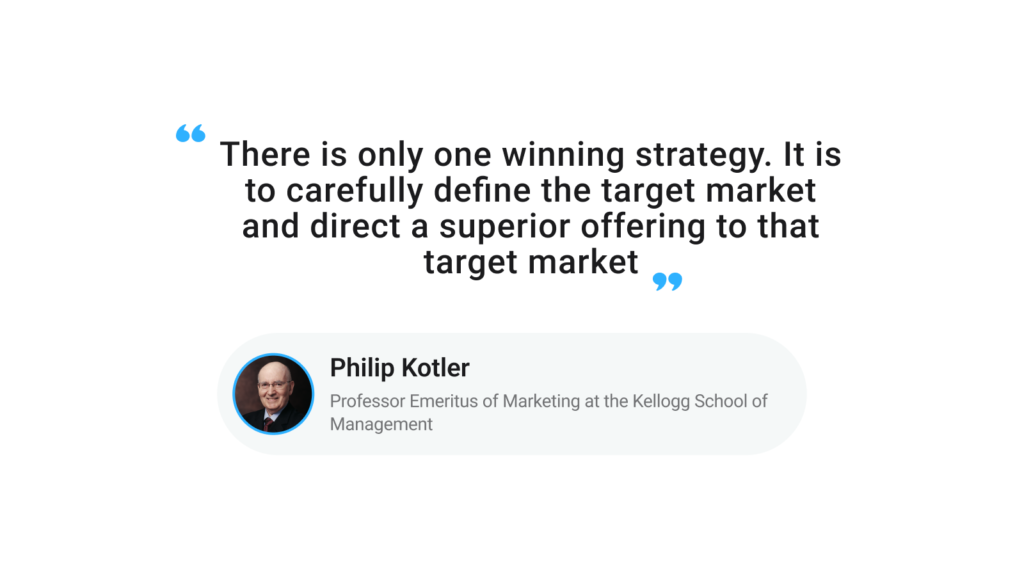
In this article, I will explain the importance of B2B market segmentation and compare it with B2C segmentation. I will also describe various methods for segmentation and provide a step-by-step plan to follow. My goal is to help you improve your marketing and sales strategies by connecting with your audience and increasing engagement, conversion rates, and revenue. Let’s dive in!
Key Data and Statistics:
- Market Segmentation Growth: The global market segmentation industry is projected to grow by 8.2% annually through 2025.
- Conversion Rate Improvement: Businesses using advanced segmentation have seen an average increase in conversion rates by up to 30%.
- Email Marketing Efficiency: Segmented email campaigns achieve 14.31% higher open rates compared to non-segmented campaigns.
- ROI on Personalization: 79% of organizations that exceeded revenue goals have a documented personalization strategy, which includes segmentation.
- Customer Retention: 56% of businesses say personalized communication, driven by segmentation, is key to customer retention.
- Increased Revenue: Companies using data-driven personalization report a 5-15% increase in revenue.
- Sales Productivity: Sales reps see a 27% improvement in productivity with a segmented approach to their prospects.
- Marketing Automation Success: 80% of marketers using automation software generate more leads, and 77% convert more of those leads.
- AI in Segmentation: 84% of marketing organizations are implementing or expanding AI and machine learning in 2023 for better market segmentation.
- Customer Satisfaction: Segmented and personalized marketing strategies lead to a 20% increase in customer satisfaction.
- Decision Making: 94% of businesses believe data and analytics are important to their digital transformation and segmentation efforts.
- B2B Buyer Expectations: 72% of B2B customers expect a deep understanding of their needs, facilitated by effective segmentation.
- Social Media Targeting: Businesses using segmentation in social media advertising see an average click-through rate increase by 37%.
- Predictive Analytics: 58% of businesses leveraging predictive analytics for segmentation report a significant increase in customer engagement.
- Content Marketing Relevance: 78% of consumers say personally relevant content increases their purchase intent, underscoring the need for targeted segmentation.
Quickly Select the Right Tool for Your Needs:
B2B segmentation involves dividing a market of potential business clients into groups based on various factors like industry, company size, or specific needs. Here’s how each of these tools can be useful for B2B segmentation:
1. Survicate
Use: Gather feedback from current customers to understand different segments’ needs and preferences.
Benefit: Tailor marketing and product development efforts to each segment.
2. Baremetrics
Use: Analyze customer data from subscription services to identify trends and segment behaviors.
Benefit: Customize offerings and communications for different business segments.
3. UpLead
Use: Access detailed company information to identify and target specific business segments.
Benefit: Efficiently focus resources on the most promising segments.
4. SEMrush
Use: Conduct market analysis and keyword research to understand the online behavior of different segments.
Benefit: Optimize content and SEO strategies for targeted business groups.
5. BrandMentions
Use: Monitor brand mentions across various industries and company sizes.
Benefit: Identify and understand different segments talking about your brand.
6. Typeform
Use: Create custom surveys and forms to collect data for segment analysis.
Benefit: Gain insights into the specific needs and preferences of different business segments.
7. Audiense
Use: Leverage audience insights, especially on social media, to identify and understand different business segments.
Benefit: Develop targeted social media strategies.
8. LeadFuze
Use: Generate leads with specific filters to target desired business segments.
Benefit: Create focused marketing and sales campaigns for each segment.
9. Hunter.io
Use: Find and verify email addresses within targeted business segments.
Benefit: Facilitate direct and personalized outreach to each segment.
10. DealFront
Use: Identify and analyze companies involved in mergers and acquisitions for segmentation.
Benefit: Tailor services and communications to meet the unique needs of this segment.
11. Apollo.io
Use: Utilize sales intelligence data to define and approach specific business segments.
Benefit: Develop precise sales strategies for each segment.
12. ZoomInfo
Use: Leverage detailed B2B contact and company information for segmentation.
Benefit: Accurately target marketing and sales efforts.
13. SurveySparrow
Use: Conduct engaging surveys to gather detailed insights about different business segments.
Benefit: Develop targeted strategies based on segment-specific feedback.
14. BuzzSumo
Use: Research content trends and popularity within specific business sectors.
Benefit: Create content strategies that resonate with each segment.
15. Metadata.io
Use: Utilize AI-driven insights to target and engage with specific business segments on social and search platforms.
Benefit: Automate and optimize marketing campaigns for each business segment.
Each tool offers unique features that can be strategically used for effective B2B segmentation, allowing businesses to cater more specifically to the needs and characteristics of different market segments.
What is B2B market segmentation?
B2B segmentation is a powerful marketing technique allowing businesses to understand their customers truly. Companies can create personalized messages that resonate with each group by identifying distinct segments based on shared characteristics.
This helps to ensure that every customer feels heard and appreciated, ultimately driving business growth. With B2B market segmentation, businesses can unlock new levels of success and build lasting relationships with their customers.
 Why is B2B customer segmentation important?
Why is B2B customer segmentation important?
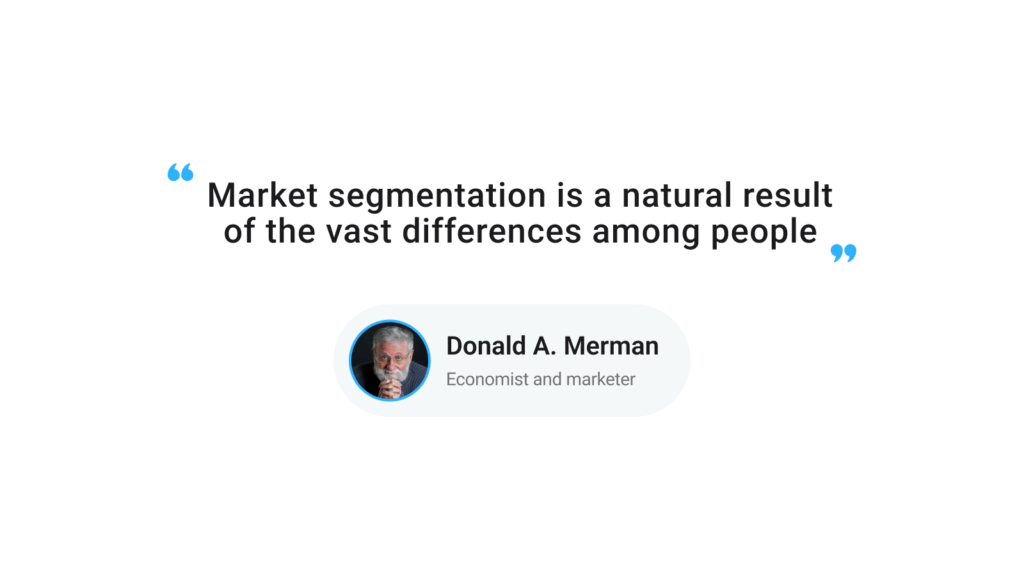
By segmenting B2B customers, businesses can gain a deeper understanding of their clients’ unique needs, enabling them to provide personalized marketing and services. This approach optimizes the allocation of resources and reduces expenses, leading to improved customer acquisition and retention rates. B2B segmentation is a powerful tool for expanding your business and strengthening customer relationships.
Customer segmentation refers to the process of grouping customers based on their demographics, firmographics, behaviors, or needs. This helps businesses to understand their customers better and tailor their products, services, and marketing efforts to meet each segment’s specific requirements.
Volodymyr Khomichenko (Tech B2B Marketing Strategist)
There are various ways to segment customers, and the methods can be used alone or in combination to create more detailed and nuanced segments. Some of the common segmentation methods include demographic, firmographic, behavioral, technographic, needs-based, tier-based, and value-based segmentation.
Modern customer segmentation relies heavily on technology and data analytics, as they help businesses collect, analyze, and utilize large amounts of customer data to create more accurate and effective customer segments. This can ultimately lead to improved customer satisfaction and loyalty, and drive growth and success for the business.
🔒 Its purpose is to increase customer retention. Create a positive experience for clients when you resolve their problems.
🎯 Improves your business focus because you will only target a few prospects.
📊 Must understand a clean database for segmentation. This will help you find trends and common qualities you may have missed.
💼 Correct segmentation helps you to meet the needs of your B2B clients, leading to revenue growth over time.
🚀 It helps you understand pain points and develop new products to solve customer problems.
📚 Improve experience clients learning types of information sources your clients.
🌍 You will discover new markets in which to expand your business.
Advantages of B2B segmentation
Segmentation is helpful for companies to categorize their clients based on different attributes. This helps to improve marketing efficiency and effectiveness by tailoring marketing efforts to specific segments, resulting in more relevant and targeted communication. Segmentation also helps optimize resources by allowing businesses to allocate them more effectively to high-value segments.
Moreover, B2B segmentation assists in product development by enabling businesses to design products or services that meet the unique needs of each segment. Lastly, it provides insights that help companies effectively differentiate their products and services, thus facilitating a competitive advantage.
Why should you segment your B2B customers:
🔹 Boost revenue: Reaching out to your target audience will increase conversion rates.
🔹 Higher ROI: Such targeted initiatives offer a higher ROI, giving you the same outcomes with less money.
🔹 Increase the creation of new products: You better suit your client’s needs and build different items for various customer groups.
🔹 Opportunity for growth: Once you start dividing your audience, you’ll discover groups that haven’t been enabled to reach out to before.
🔹 Improve the consumer experience: The customer experience improves when a company provides more suitable solutions.
Furthermore, it enhances customer acquisition efforts, as targeted messaging increases conversion rates. It also boosts customer retention by consistently addressing evolving needs and pain points.
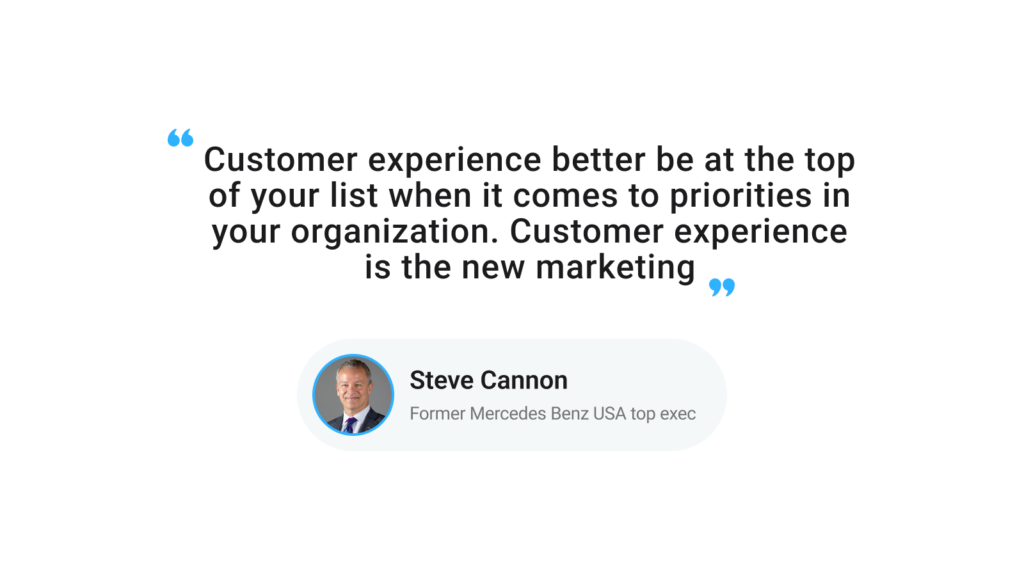
In addition, segmentation supports product and service customization, ensuring they align with each segment’s requirements. Ultimately, B2B customer segmentation strengthens competitiveness and fosters long-lasting, profitable relationships.
Mailchimp compared segmented marketing campaigns versus non-segmented campaigns using user data. Mailchimp’s analysis demonstrates crucial for customer segmentation:
#️⃣ Open rates for segmented email marketing jumped by 14.3%.
#️⃣ Click-through rates doubled.
#️⃣ Bounce rates were 4.6% lower.
#️⃣ The number of unsubscribes was 9.4% lower.
How B2B segmentation differs from B2C segmentation
B2B segmentation and B2C segmentation operate on fundamentally different principles due to the nature of their target audiences. B2B segmentation often places a premium on other businesses’ needs, purchasing processes, and organizational structure. Typically, B2B segments are characterized by more complex decision-making processes involving multiple stakeholders than the often singular, more impulsive decisions made by individual consumers in B2C.
B2C segmentation, on the other hand, focuses more on the personal preferences, behaviors, lifestyles, and demographics of individual consumers. Moreover, the messaging and marketing strategies stemming from B2B and B2C segmentation are markedly different, with B2B focusing on value, efficiency, and long-term ROI, while B2C emphasizes emotional appeal, benefits, and personal satisfaction.
 What makes B2B segmentation unique:
What makes B2B segmentation unique:
➡️ B2B purchases involve a high level of involvement, and clients seek customized solutions.
➡️ There are no spontaneous buys. In comparison to the B2C, B2B buyers are incredibly rational.
➡️ There are multiple those making decisions. B2B purchases involve multiple decision-makers from various areas of the company.
➡️ The buying process is significantly longer.
➡️ B2B products and services are frequently more complicated.
➡️ The B2B buying cycle is different.
➡️ B2B target audiences are smaller.
➡️ Personal relationships matter more.
Customer B2B segmentation methods
Let’s look at some of the best B2B customer segmentation cases. How they may help companies enhance their effectiveness:
🔹 Segmentation by firmographics
🔹 Segmentation by tier
🔹 Segmentation by need
🔹 Segmentation by customer sophistication
🔹 Segmentation by behavior
🔹 Segmentation by decision-makers
🔹 Segmentation by profitability
🔹 Segmentation by Jobs-To-Be-Done
🔹 Segmentation by journey stage segmentation
🔹 Segmentation by technographic
B2B segmentation by firmographics
Segmenting B2B customers by firmographics involves categorizing companies based on measurable attributes like size, location, industry, and revenue. This is similar to demographic segmentation in B2C markets, and it helps target potential customers more accurately. Employing firmographic segmentation allows businesses to develop tailored marketing and sales strategies that resonate well with each segment’s characteristics.
Companies can offer more relevant and appealing products and services by understanding different firmographic segments’ varying needs and challenges. This method enhances lead generation and conversion process efficiency, ensuring efforts are directed toward the most promising and relevant prospects.
What this type of segmentation allows you to do:
- Categorization by company attributes: Segmenting businesses based on attributes such as size, location, industry, and revenue.
- Tailored marketing strategies: Developing marketing and sales strategies that are customized to resonate with the characteristics and needs of each firmographic segment.
- Enhanced relevance and appeal: Offering products and services that are more relevant and appealing to the specific needs and challenges of different firmographic segments.
- Efficient lead generation: Directing lead generation and conversion efforts more efficiently toward the most relevant and promising prospects based on firmographic attributes.
- Increased precision in targeting: Firmographic segmentation increases the precision in targeting potential customers, enabling more effective and relevant engagements.
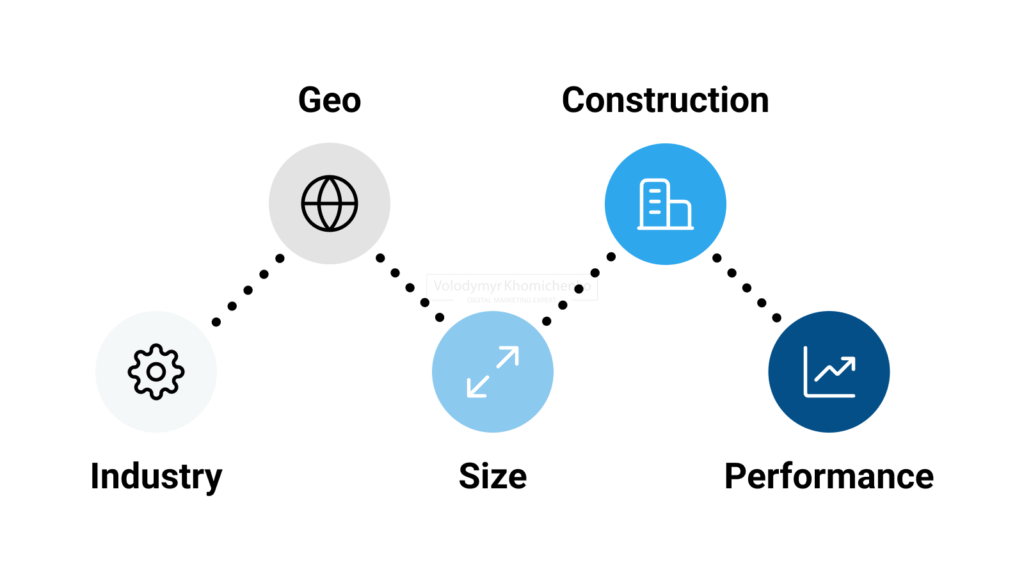
Firmographics can include:
🏭 Industry
🏢 Company size
🌎 Location
💰 Revenue
👥 Customer type (B2B, B2C, B2G)
📈 Growth trends
B2B segmentation by tier
Segmenting B2B customers by tier involves categorizing clients into different levels, usually based on their value to the company, such as revenue generated, volume of purchases, or strategic importance. This method enables businesses to allocate resources, time, and effort more efficiently, prioritizing high-value clients.
Tiered segmentation helps customize service levels, offers, and interactions to suit each tier’s specific needs and expectations, enhancing customer satisfaction and loyalty. It also assists in refining marketing and sales strategies to align with the value and potential of each client tier. Businesses can optimize customer experiences and maximize customer value by addressing each tier’s needs and preferences.
What this type of segmentation allows you to do:
- Categorization by value: Clients are segmented into different levels or tiers based on their value to the company, such as revenue contribution or strategic importance.
- Efficient resource allocation: This method allows for a more precise allocation of resources, time, and effort, with prioritization given to higher-value clients.
- Customized service levels and offers: Tailoring service levels, interactions, and offers to meet the specific needs and expectations of each tier enhances customer satisfaction and loyalty.
- Refined marketing and sales strategies: Developing marketing and sales approaches that are aligned with the value and potential of each client tier optimizes the impact and effectiveness of strategies.
- Optimized customer experiences: Addressing the unique needs and preferences of each tier allows businesses to enhance customer experiences and maximize the value derived from each client segment.
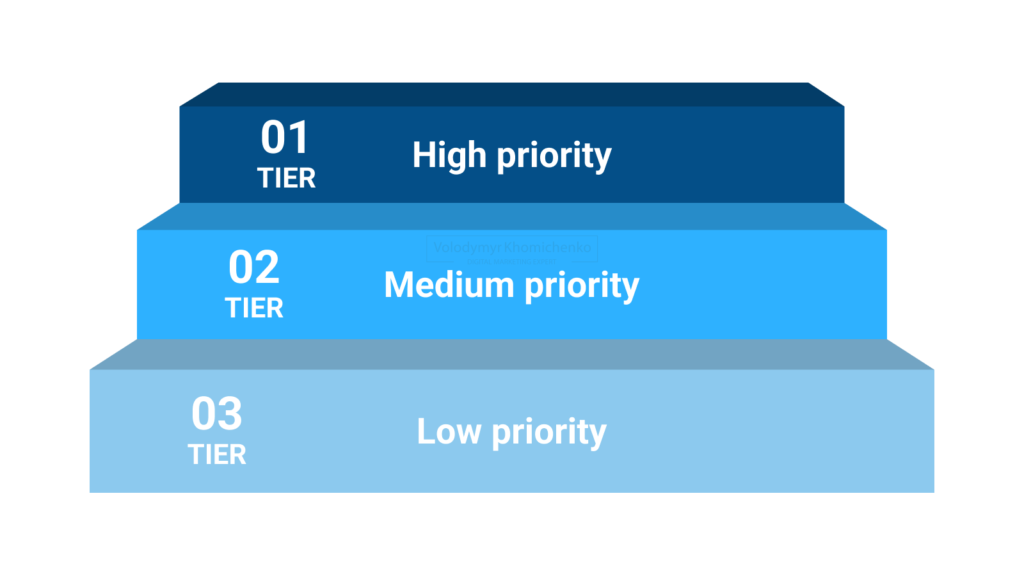
Tier-based segmentation considers the lead’s potential worth. This can be performed in several ways:
⏳ Customer lifetime value on average
📢 Channel of acquisition (different channels may have a varied cost per lead or lifetime value)
🔍 Lead quality (by lead scoring)
B2B segmentation by need
Segmenting B2B customers by needs involves classifying companies based on their specific requirements, challenges, and pain points. By understanding the distinct needs of each segment, businesses can develop and deliver more tailored and relevant products, services, and solutions. This method enhances the precision of marketing and sales strategies, allowing for messages that resonate more strongly with target audiences.

Identifying and addressing the unique needs of each segment can lead to stronger customer relationships, higher satisfaction, and increased loyalty. Additionally, need-based segmentation helps develop innovative solutions that address unmet or underserved needs in the market.
What this type of segmentation allows you to do:
🟣 Classification by requirements: Customers are segmented based on their specific needs, challenges, and requirements, allowing a deeper understanding of their pain points.
🟣 Tailored products and services: Developing products, services, and solutions that are closely aligned with the needs of each segment, ensuring relevance and appeal.
🟣 Precision in marketing and sales strategies: Crafting marketing and sales messages that resonate with the specific needs of the target audience, enhancing the impact and effectiveness of communication.
🟣 Stronger customer relationships: Addressing the unique needs of each segment fosters better relationships, increased satisfaction, and higher levels of customer loyalty.
🟣 Innovative solution development: Identifying and addressing unmet or underserved needs leads to the innovation of new products and services that fill gaps in the market.
B2B segmentation by customer sophistication level
Segmenting B2B customers by sophistication level involves categorizing clients based on their knowledge, experience, and expertise in a specific area or industry. This approach allows companies to tailor their products, services, and communication strategies to match the level of sophistication of each segment. For instance, highly sophisticated segments may prefer advanced features and detailed information, while less sophisticated segments may value simplicity and ease of use.
This segmentation method helps create more relevant and compelling value propositions, increasing customer satisfaction and loyalty. It also ensures that resources are allocated efficiently, targeting the right customers with the right level of sophistication with appropriate products and services.
What this type of segmentation allows you to do:
🔵 Categorization by expertise: Segmenting customers based on their knowledge, experience, and expertise in a specific domain or industry.
🔵 Tailored products and communication: Creating products, services, and communication strategies that align with the sophistication level of each customer segment, ensuring relevance and appeal.
🔵 Enhanced value propositions: Developing compelling and relevant value propositions that resonate with the varying levels of customer sophistication, enhancing satisfaction and loyalty.
🔵 Efficient resource allocation: Allocating resources more effectively by targeting customers with the appropriate level of sophistication with suitable products and services.
🔵 Increased customer satisfaction: Meeting each sophistication level’s specific needs and preferences leads to higher customer satisfaction and more meaningful engagements.
B2B segmentation by behavior
Segmenting B2B customers by behavior involves categorizing them based on their actions, interactions, and engagement with a company’s products or services. This method enables businesses to understand customers’ needs, preferences, and habits, allowing for more personalized and effective marketing strategies. Behavioral segmentation in the B2B context often includes analyzing purchasing behaviors, usage patterns, and responsiveness to marketing efforts.
By focusing on behavior, companies can identify patterns and trends, enabling them to predict future behaviors and optimize their marketing efforts accordingly. This approach also aids in customer retention by allowing businesses to tailor their services and communications based on customer behavior, enhancing satisfaction and loyalty.
What this type of segmentation allows you to do:
🔵 Categorization by actions: Customers are segmented based on interactions, engagement, and actions related to a company’s products or services.
🔵 Understanding customer needs: Behavioral segmentation provides insights into the needs, preferences, and habits of customers, enabling the creation of more personalized and relevant marketing strategies.
🔵 Analysis of purchasing behaviors: Analyzing behaviors like purchasing patterns and responsiveness to marketing allows companies to optimize their strategies and approach customers more effectively.
🔵 Prediction of future behaviors: Identifying patterns and trends in customer behavior enables companies to anticipate future actions and optimize their marketing and sales efforts accordingly.
🔵 Enhanced customer satisfaction and loyalty: Tailoring services and communications based on customer behavior increases satisfaction and loyalty by meeting customers’ specific needs and preferences.
This information can be got by looking at the following:
👀 Prospects who visit your website
📱 Prospects interact with the content
🤝 Customers’ interactions with your product or services
B2B segmentation by decision-makers
Segmenting B2B customers by decision-makers involves identifying and categorizing the individuals within client organizations with the authority to make purchasing decisions. This approach allows companies to tailor their communication and marketing strategies to the preferences and needs of these key individuals. Understanding the priorities and concerns of decision-makers can lead to more effective sales strategies and higher conversion rates.
This segmentation often involves an analysis of job roles, influence levels, and specific needs and preferences of individuals. Businesses can foster stronger, more personalized relationships by focusing on decision-makers, leading to increased customer loyalty and retention.
What this type of segmentation allows you to do:
🟢 Identification and categorization: Recognizing the individuals with purchasing authority within client organizations.
🟢 Tailored communication: Developing marketing and communication strategies that align with the preferences and needs of decision-makers.
🟢 Effective sales strategies: Understanding the priorities and concerns of decision-makers enables the creation of more compelling and convincing sales approaches, leading to higher conversion rates.
🟢 Analysis of individuals: Evaluating job roles, levels of influence, and specific needs and preferences of decision-makers to tailor approaches effectively.
🟢 Relationship building: Focusing on personalization and value addition to build stronger, long-lasting relationships with decision-makers, increasing customer loyalty and retention.
You can identify the organization’s decision-makers. Hunter and Snovio are two tools that can help identify decision-makers’ email addresses and contacts.
B2B segmentation by profitability
Segmenting B2B markets by profitability involves categorizing clients based on their revenue generation potential or contribution to the bottom line. This method allows companies to identify and prioritize high-value clients and allocate resources, efforts, and attention more effectively to retain them. Companies can optimize their marketing strategies by focusing on the most profitable segments to boost revenue and reduce unnecessary expenditures on less lucrative segments.
This segmentation often thoroughly analyzes clients’ purchase histories, payment behaviors, and transaction volumes. Implementing strategies based on profitability segmentation enables businesses to enhance customer satisfaction and loyalty among their most valuable clients, fostering long-term relationships.
What this type of segmentation allows you to do:
🟠 Identification of high-value clients: Businesses categorize clients based on their potential to generate revenue, focusing on those contributing significantly to the bottom line.
🟠 Resource allocation: Companies allocate more resources, efforts, and attention to high-value clients to maintain and nurture those relationships.
🟠 Optimized marketing strategies: By focusing on profitable segments, businesses can refine their marketing strategies to appeal to these segments, maximizing revenue and minimizing wasteful spending on less lucrative segments.
🟠 Detailed analysis: Profitability segmentation necessitates a comprehensive examination of clients’ purchasing behaviors, payment histories, and transaction volumes to identify the most lucrative segments.
🟠 Enhancement of customer satisfaction and loyalty: By meeting the specific needs of the most valuable clients, businesses can enhance satisfaction and loyalty, fostering beneficial long-term relationships.
B2B segmentation by Jobs-To-Be-Done (JTBD)
Segmenting B2B customers by Jobs-To-Be-Done (JTBD) involves understanding the specific tasks companies need to accomplish with the products or services. This method helps identify the unmet needs and challenges the customers face and offers solutions tailored to resolve those specific issues. By focusing on the jobs that customers need to be done, businesses can innovate and create products or services that precisely align with customer requirements.
This approach enhances customer satisfaction and loyalty as it provides value by fulfilling the customer’s exact needs. Utilizing JTBD for segmentation ensures a customer-centric approach, allowing for the developing of meaningful and relevant value propositions.
What this type of segmentation allows you to do:
- Understanding specific tasks: Identifying and understanding the specific jobs or tasks businesses are trying to accomplish with products or services.
- Identifying unmet needs: Recognizing customers’ challenges and unmet needs to offer tailored and practical solutions.
- Innovation and alignment: Focusing on customer needs allows for the innovation of products and services that align precisely with what the customer requires.
- Enhancement of customer satisfaction and loyalty: Providing value by fulfilling the exact needs enhances customer satisfaction and encourages loyalty.
- Development of meaningful value propositions: A JTBD approach ensures the development of customer-centric and relevant value propositions, making the offerings more appealing to the customers.
B2B segmentation by journey stage
Segmenting B2B customers by journey stage involves categorizing clients based on their position in the buying process, from awareness to consideration to purchase. This approach allows businesses to deliver the right message or intervention at the appropriate time, enhancing the effectiveness of marketing strategies. Recognizing clients’ needs at each stage enables companies to customize their approaches, improving engagement and conversion rates.
Employing journey stage segmentation aids in optimizing resource allocation, ensuring that efforts are concentrated on moving clients forward in their journey. It also helps refine overall strategy, allowing for adjustments based on customer response at each stage.
What this type of segmentation allows you to do:
🔴 Categorization by buying process: Clients are segmented based on their positions in the buying process, ranging from awareness to purchase.
🔴 Targeted messaging: Delivering appropriate messages or interventions at each stage enhances the relevancy and effectiveness of marketing efforts.
🔴 Customized approaches: Understanding the unique needs at each stage allows for developing tailored strategies to improve engagement and conversions.
🔴 Optimized resource allocation: Focusing efforts and resources on specific stages ensures that clients are efficiently progressed through their journey.
🔴 Refined overall strategy: Journey stage segmentation facilitates strategic adjustments based on customer responses and behaviors at each stage, allowing for more effective marketing and sales strategies.
You may be familiar with the general stages of the funnel. Awareness, deliberation, and decision — but there’s more to think about:
🎯 Qualified: The account matches the description of your target account, although they may be unfamiliar with your brand.
📢 Aware: The account in question is aware of your brand but has yet to fully engage with it.
🤝 Engaged: The account is interacting with you and knows your offerings. However, it has yet to demonstrate purchasing intent.
🌱 Marketing Qualified Account (MQA): The account is finally exhibiting signs of life.
🛒 Opportunity: The account is getting closer to making a decision, and you’ve involved the entire buying committee.
🎉 Customer: You succeeded! The account is now a client, but the trip is not over.
👍 Post-sale: Identify and offer additional products or services to customers when it’s the right time.
These phases will help you provide relevant and impactful messaging to your business.
B2B segmentation by technographic
Segmenting B2B customers by technographics involves categorizing companies based on their technology-related behaviors, preferences, and characteristics. This method enables businesses to understand their customers’ technology stack, software usage, and overall technological maturity. By identifying technographic segments, companies can tailor their product offerings, marketing strategies, and sales approaches more precisely to meet the needs and preferences of each segment.
Technographic segmentation aids in pinpointing opportunities for upselling and cross-selling based on the technological needs and gaps identified within target companies. It also helps optimize communication and engagement strategies by aligning them with the technical preferences of the customers.
What this type of segmentation allows you to do:
- Understanding technology usage: Technographic segmentation categorizes companies based on their use, knowledge, and technology preferences, helping understand customers’ technology stack and maturity.
- Tailored product offerings: Companies can create more relevant and appealing product offerings and services by aligning them with each segment’s identified technological behaviors and preferences.
- Identifying sales opportunities: Understanding the technological needs and gaps of target companies enables businesses to identify opportunities for upselling and cross-selling more effectively.
- Optimized communication strategies: By aligning engagement and communication strategies with customers’ technology preferences, companies can enhance the relevance and effectiveness of their interactions.
- Enhanced customer satisfaction: Tailoring products and services to meet customers’ technological needs and preferences results in higher satisfaction and loyalty.
Challenges involved in B2B customer segmentation
In B2B customer segmentation, one common challenge is the complexity and diversity of organizational structures and needs, making identifying clear, distinct segments difficult. Data availability and quality can pose significant hurdles, as accurate or complete data can lead to better-defined segments.
Additionally, gaining consensus among internal stakeholders on segmentation criteria and strategies can be harsh due to differing opinions and objectives. The dynamic nature of B2B markets requires continuous refinement of segmentation models, adding another layer of difficulty.
Finally, implementing tailored strategies for each segment can be resource-intensive and may strain organizational resources and capacities. Some challenges in B2B segmentation:
🔴 There are numerous things to consider while making a decision.
🔴 Because B2B products are more complex than B2C products, you must consider them from any viewpoint.
🔴 In B2B marketing, building personal relationships with top decision-makers can be challenging.
🔴 Because B2B decision-makers are long-term buyers, they tend to take their time when making a decision, which can lengthen the sales cycle.
Success Metrics: Measuring the Effectiveness of B2B Segmentation Strategies
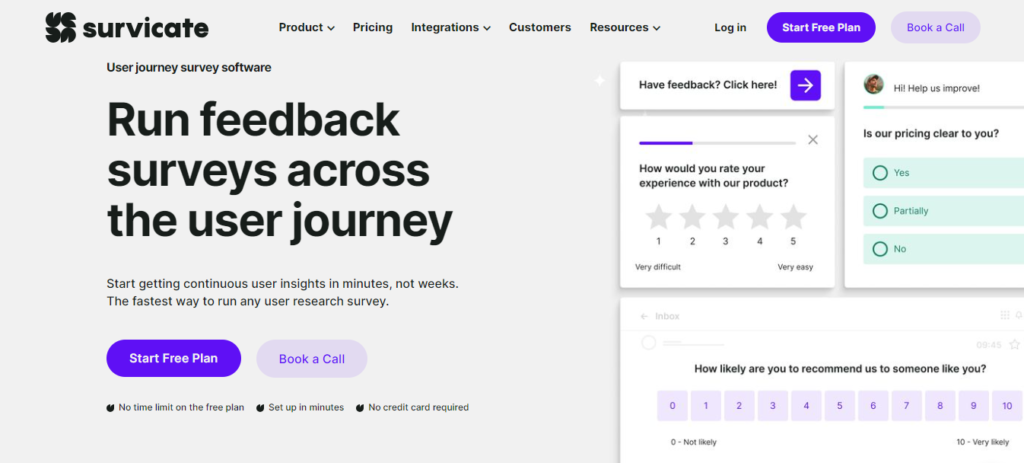
To effectively measure the success of B2B segmentation strategies, businesses need to track specific metrics and Key Performance Indicators (KPIs). These metrics provide insights into how well the segmentation aligns with business objectives and customer needs. Here are key metrics and KPIs to consider:
- Customer Acquisition Cost (CAC): This measures the total cost of acquiring a new customer. Successful segmentation should lead to a lower CAC as marketing efforts are more targeted and efficient.
- Lead Conversion Rate: This is the percentage of leads that convert into customers. Effective segmentation often results in higher conversion rates as marketing messages resonate more with targeted segments.
- Customer Lifetime Value (CLV): CLV is the total revenue a business can expect from a single customer account. Segmentation strategies that effectively identify and nurture high-value customers can significantly increase CLV.
- Segment Growth Rate: Track the growth rate of each segment. A healthy growth rate in key segments indicates successful targeting and engagement strategies.
- Engagement Metrics: These include metrics such as email open rates, click-through rates, social media engagement, and website interaction. Higher engagement within a segment suggests that the content and communication are well-tailored.
- Customer Retention Rate: This measures how well a business retains its customers over a period. Segmentation strategies focused on customer retention should see an increase in this rate.
- Net Promoter Score (NPS): NPS assesses customer loyalty and satisfaction. Segment-specific NPS can indicate how well each segment is responding to tailored strategies.
- Sales Cycle Length: Monitoring changes in the sales cycle length can reveal the efficiency of segmentation strategies. A shorter cycle often means that marketing and sales efforts are more effective.
- Market Share in Target Segments: Analyze the market share within each targeted segment. An increase suggests successful penetration and effectiveness of segmentation.
- Return on Marketing Investment (ROMI): This is the return generated for every dollar spent on marketing. Effective segmentation should ideally lead to a higher ROMI.
- Segment Profitability: Evaluate the profitability of each segment. This helps in identifying the most lucrative segments and optimizing resource allocation.
- Customer Satisfaction Index (CSI): This index measures how satisfied customers are with your products or services. Higher satisfaction in a targeted segment indicates successful customization and relevance of offerings.
How to segment the B2B market. A practical framework for B2B market segmentation
Keeping this in mind, here is a step-by-step guide to creating client segmentation:
🎯 Determine your goals. To effectively segment clients, start by defining your objectives. Determine whether you want to optimize marketing strategies, improve product development, or enhance customer relationships. Once you have a clear goal in mind, tailor your approach to suit your company’s industry, size, and which departments will be involved, such as marketing or sales.
👥 Select your groups, identify segmentation criteria. To achieve your objectives, it’s important to choose the most suitable segmentation criteria, such as firmographics, needs, behavior, and customer journey stage, that align with your business goals. By doing so, you can effectively categorize your customers.
For instance, if you have a small yet expanding customer base of middle-aged women, you can utilize demographic segmentation to gain insights into their age and gender groups and focus your marketing efforts on them. Make use of your past customer data to enhance your strategies.
📋 Data collection and analysis. Collect high-quality and relevant data from credible sources like CRM systems, surveys, and market research. Analyze data to identify trends, patterns, and insights that inform segmentation.
🎯 Identify your target account list (TAL). Typically, the list of accounts in your target market is still too huge to work with. This is when constructing a TAL comes into play.
You probably already have a list of essential accounts you wish to sell to. You can use these accounts to establish your initial TAL and add to it later to include a broader range of organizations reflecting your best chances.
🧩 Segment and prioritize your audiences. Break your TAL’s target accounts into an audience—groups of prospects or current consumers who suit well with specific marketing activities.
Enter firmographic, technographic, intent, identity, and journey stage segmentation approaches.
📝 Segment creation and profiling. Develop clear and distinct segments with similar needs, behaviors, or characteristics and create comprehensive profiles outlining the attributes and needs of each segment.
💡 Develop tailored strategies. Create segment-specific marketing, sales, and product development strategies aligned with each segment’s unique needs and characteristics to maximize impact and relevance.
🔍 Implementation and execution. After categorizing your clients, it is important to execute targeted strategies that cater to their specific needs and preferences. This means ensuring that all actions, communications, and interactions are aligned with each segment. To effectively reach out to these segments, it is crucial that your departments have a deep understanding of the customer groups and their demands.
Collaborate with your team to create fresh, engaging content that resonates with your intended market segments. Additionally, take note of the common characteristics of qualified clients within your newly formed groups.
📈 Monitor, measure, and optimize. Evaluate segmentation strategies, track their performance, and adjust them as needed based on market changes and KPIs. Use data from sales and marketing to assess the impact of segmentation and update the customer organization accordingly.
🔄 Continuous refinement. To ensure sustained relevance and effectiveness, refine the segmentation model and strategies in response to market changes, emerging opportunities, and evolving business objectives.
Practical Tips
- Customer-centric approach: Keep the customer at the center of all segmentation efforts, focusing on their needs, challenges, and preferences.
- Flexibility and adaptability: Maintain a flexible approach, adapting to changes in market conditions, customer behaviors, and business objectives.
- Stakeholder alignment: Ensure that all relevant stakeholders are aligned on the segmentation objectives, criteria, and strategies.
- Use B2B customer segmentation tools: Customer segmentation software may be helpful through the process of gathering and evaluating data for you.
Let’s talk about tools.
What does a customer segmentation tool do?
You have a clear understanding of audience segmentation and its functionality. The role of consumer segmentation tools in this process is significant. These tools are designed to assist you in locating, organizing, and utilizing data necessary for establishing efficient consumer segments. They help automate technical processes, ensure effective audience targeting, and save time for personnel to focus on revenue-generating activities.
With the help of segmentation tools, data is collected from various sources and organized, freeing staff from managing and updating data. This allows them to concentrate on more critical tasks.
Features to look for in a customer segmentation tool
🏢 Organization: Excellent software tracks customers’ information. It provides a unified view of your consumers and what they like about your company and marketing efforts.
🛠️ Customizability: You can compare data across multiple consumer segments. If client happiness falls, you should be able to review your software and determine which consumers are dissatisfied.
👁️🗨️ Visibility: Effective client segmentation software offers visually engaging tools to assess data. Good software presents dynamic, shareable charts and graphs for effortless exploration.
📈 Scalability: A good piece of software will be easy to use, suitable for even tiny companies, and scalable.
15 Market Segmentation Tools to Make Customer Research
Survicate

Survicate is a software platform for gathering and analyzing customer feedback and survey data. It enables businesses to create and distribute surveys to gain insights into customer preferences and satisfaction. Survicate provides real-time analytics to help companies make data-driven decisions. It plays a crucial role in enhancing customer engagement and refining marketing strategies. Survicate is a versatile tool for improving customer relationships and business performance.
Baremetrics
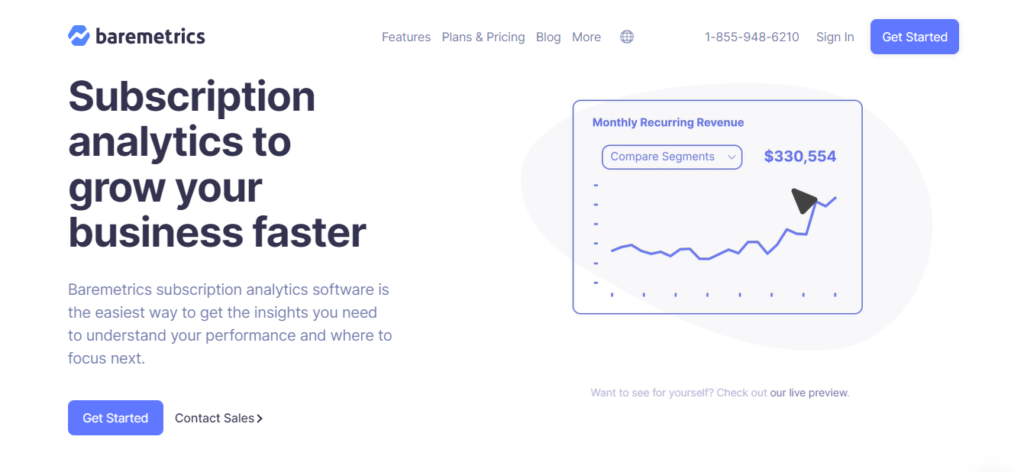
Baremetrics is a software platform that offers subscription analytics and metrics for businesses. It helps companies track key performance indicators for their subscription-based services or products. Baremetrics provides insights into revenue, churn rate, customer lifetime value, and other vital metrics. It assists businesses in making data-driven decisions to optimize their subscription models. In summary, Baremetrics is a valuable tool for subscription businesses to monitor and improve their financial performance.
UpLead

UpLead is a software platform used for lead generation and B2B sales prospecting. It provides access to a vast database of business contacts and leads. UpLead allows users to search for and filter leads based on various criteria, such as industry, location, and company size. It offers contact information, including email addresses and phone numbers, to facilitate outreach. In essence, UpLead is a valuable tool for businesses looking to find and connect with potential customers and partners in the B2B space.
SEMrush

SEMrush is a comprehensive digital marketing software and research tool used by businesses and marketers. It provides insights and data on keyword research, competitive analysis, and website performance. SEMrush helps users optimize their websites for search engines, track their rankings, and improve their online visibility. It also offers pay-per-click (PPC) advertising analysis tools and social media management. In summary, SEMrush is a versatile platform for enhancing digital marketing strategies and online presence.
BrandMentions
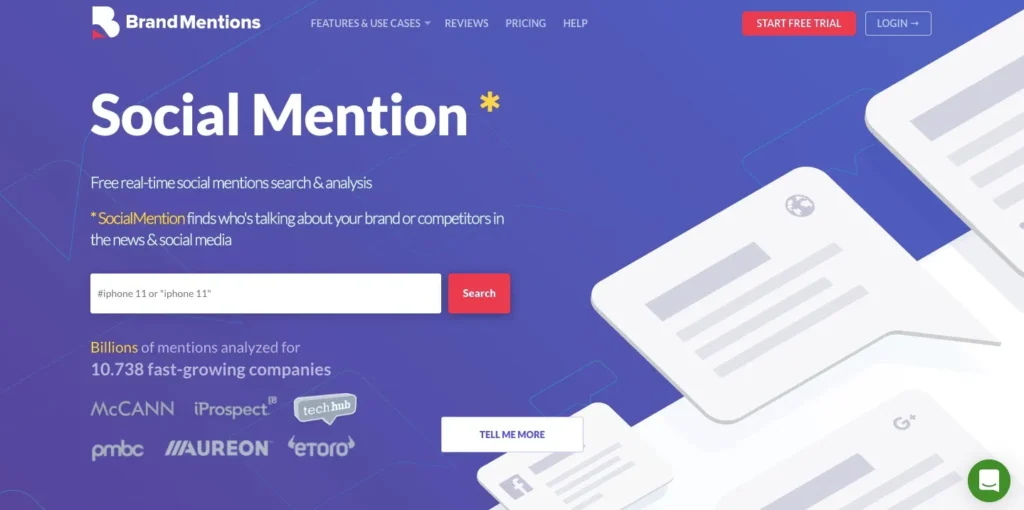
BrandMentions is a monitoring tool used for tracking brand mentions and online reputation. It scans the internet, including social media, websites, and news sources, to find references to a brand or specific keywords. BrandMentions provides real-time alerts and analytics to help businesses monitor their online presence and engage with their audience. It aids in tracking competitors and industry trends by analyzing online conversations. In essence, BrandMentions is a valuable tool for managing and improving a brand’s online reputation and visibility.
Typeform
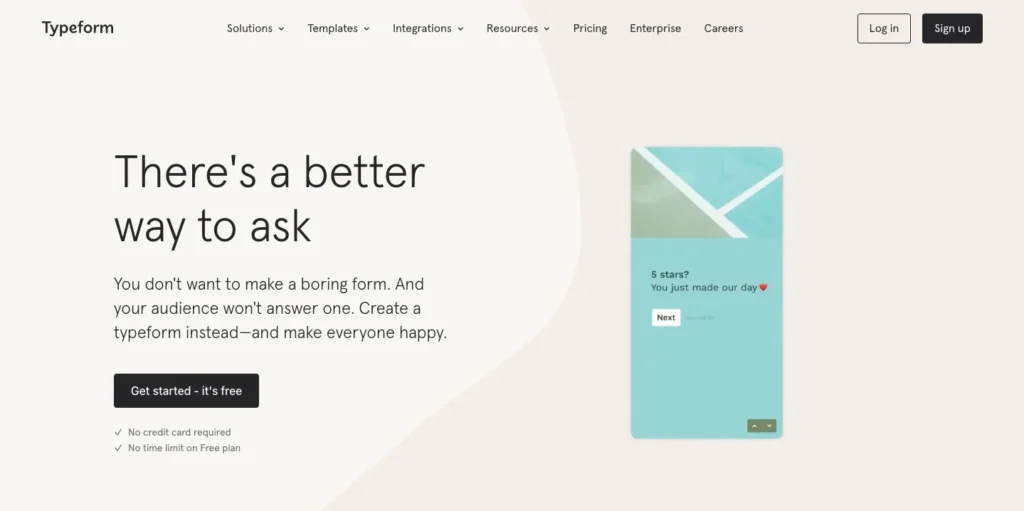
Typeform is an online survey and form-building platform. Users can create interactive and visually appealing surveys, questionnaires, and forms. Typeform is known for its user-friendly interface that encourages engaging and conversational interactions with respondents. It offers various customization options, including adding images, videos, and logic-based branching to create dynamic forms. In summary, Typeform is a versatile tool for collecting information and feedback from users in a visually appealing and interactive manner.
Audiense
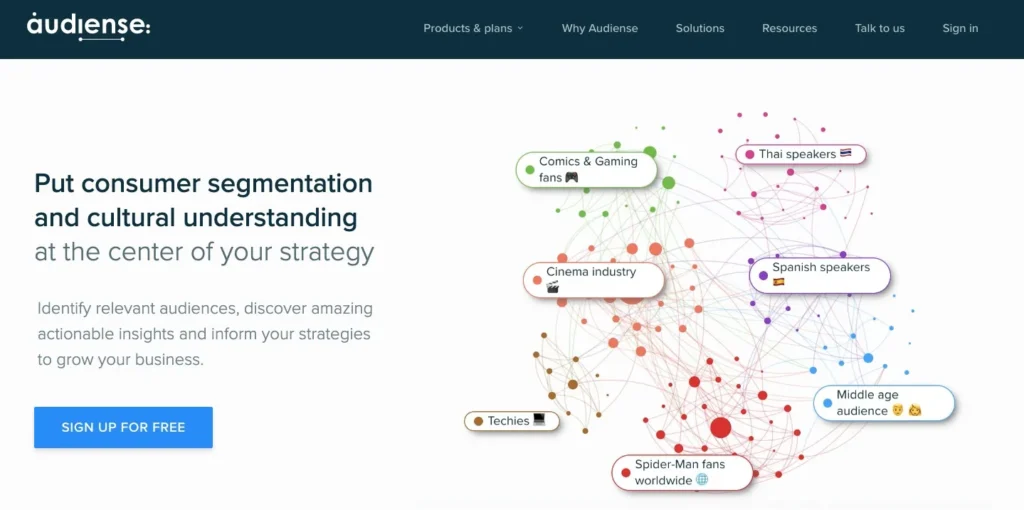
Audiense is a social media marketing platform used for audience insights and engagement. It helps businesses and marketers analyze their social media followers and audience demographics. Audiense provides tools to segment and target specific groups of followers for personalized marketing campaigns. It also offers features for scheduling and automating social media posts. In essence, Audiense is a valuable tool for understanding and engaging with your social media audience effectively.
LeadFuze
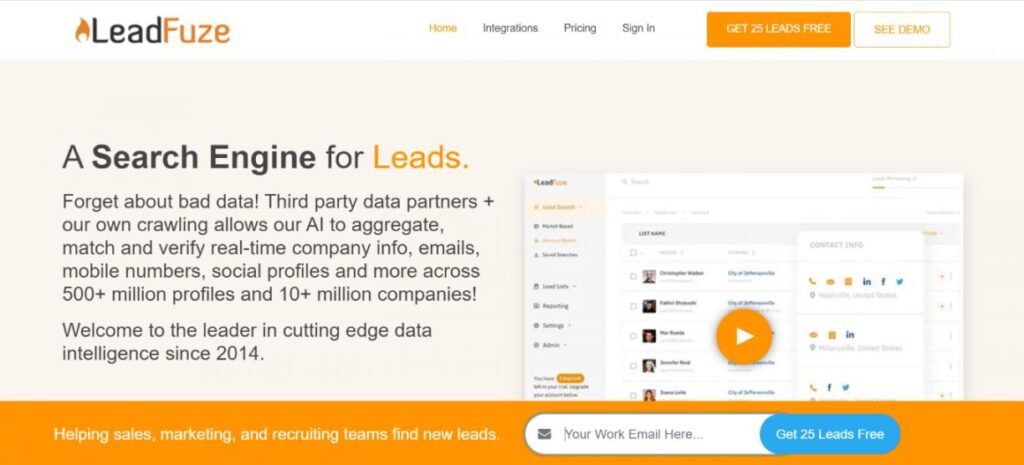
LeadFuze is a lead generation software and prospecting tool. It assists businesses in finding potential leads and contacts for their sales and marketing efforts. LeadFuze provides access to a database of business contacts, allowing users to filter and search for leads based on various criteria. It offers contact information, including email addresses and other relevant details for outreach. In summary, LeadFuze is a valuable tool for businesses looking to identify and connect with potential customers and prospects.
Hunter
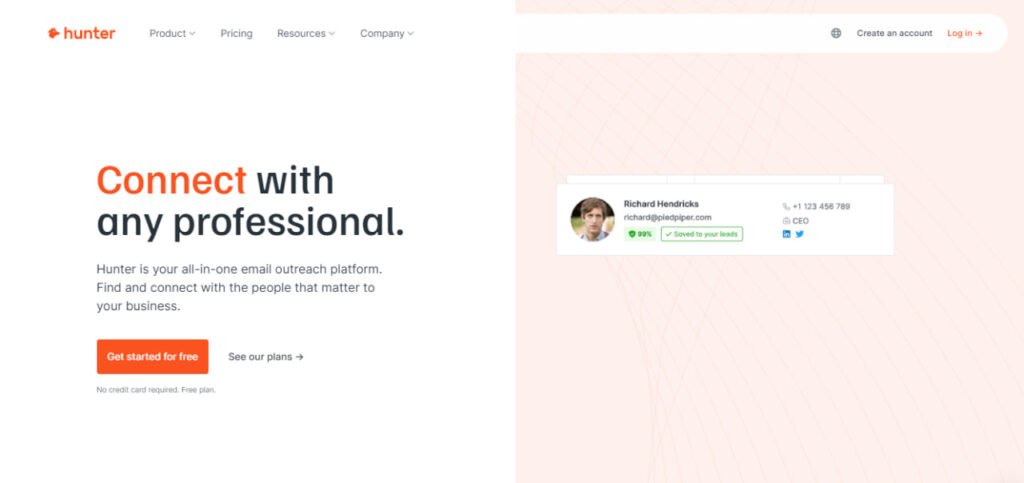
Hunter is an email finding and verification tool. It helps users find email addresses associated with a specific domain or company. Hunter also verifies the validity of email addresses to reduce bounce rates. It provides a Chrome extension for easy email searching while browsing websites. In essence, Hunter is a useful tool for businesses and professionals looking to source accurate email addresses for their outreach and communication needs.
Dealfront (Formerly Leadfeeder)
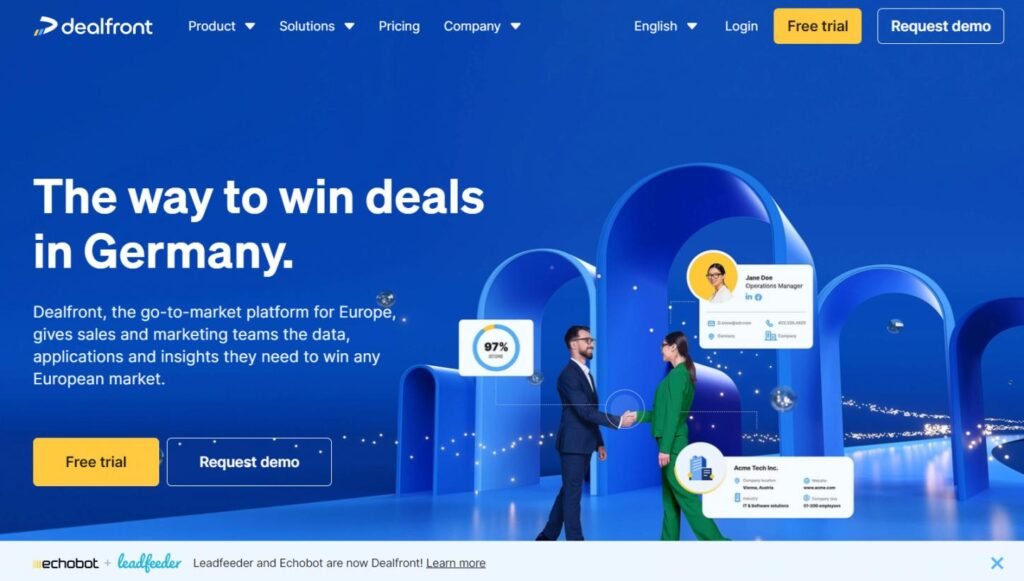
Dealfront, formerly known as Leadfeeder, is a website visitor tracking and lead generation tool. It allows businesses to identify and track website visitors, even if they don’t fill out a contact form. Dealfront provides insights into the companies that visit a website and their behavior, helping sales and marketing teams prioritize leads. It integrates with popular CRM and marketing automation platforms to streamline lead nurturing. In summary, Dealfront is a valuable tool for identifying and engaging with potential customers who visit your website.
Apollo.io
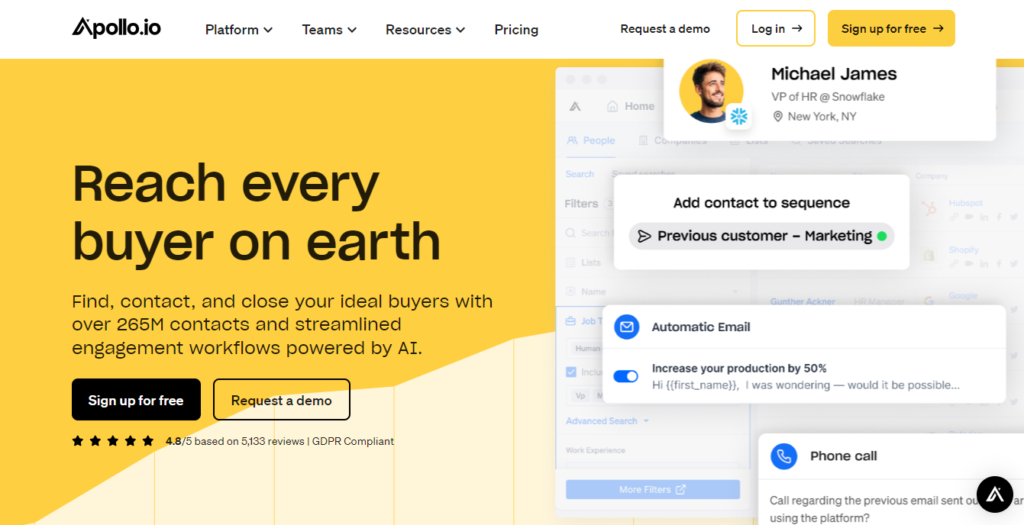
Apollo.io is a comprehensive sales intelligence and engagement platform. It provides businesses with access to a vast database of company and contact information, enabling effective prospecting and lead generation. Apollo.io offers tools for email tracking, sales outreach automation, and personalized messaging to engage with prospects. It also includes features for lead scoring and analytics to optimize sales strategies. In essence, Apollo.io is a valuable tool for sales and marketing teams to identify, connect with, and convert potential customers.
ZoomInfo
ZoomInfo is a B2B (business-to-business) contact and company database platform. It offers a vast repository of information on companies and professionals, facilitating sales and marketing efforts. ZoomInfo provides access to detailed company profiles, contact data, and organizational hierarchies to identify decision-makers and potential leads. It also offers tools for email outreach, lead generation, and prospecting. In summary, ZoomInfo is a valuable resource for businesses looking to enhance their sales and marketing strategies by providing access to accurate and comprehensive B2B data.
SurveySparrow

SurveySparrow is an online survey and feedback platform. It enables businesses and organizations to create engaging and user-friendly surveys and questionnaires. SurveySparrow stands out for its conversational survey format, which encourages higher response rates and user engagement. It offers features like multi-channel distribution, real-time analytics, and automated reporting. In essence, SurveySparrow is a valuable tool for collecting feedback and conducting surveys in a user-friendly and interactive manner.
BuzzSumo
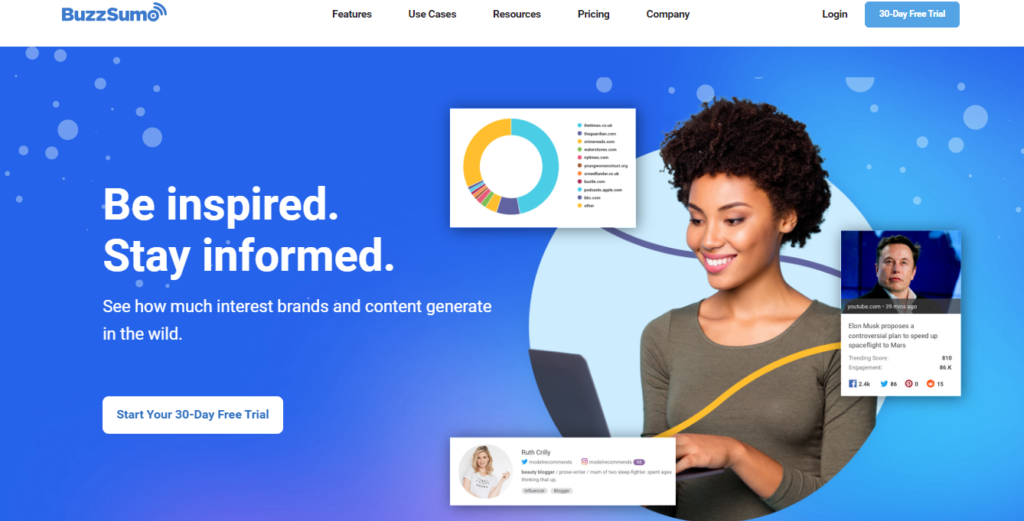
BuzzSumo is a content research and social media analysis tool. It allows users to discover the most popular and trending content across various social media platforms and the web. BuzzSumo provides insights into content performance, including the number of shares, backlinks, and engagement metrics. It helps marketers and content creators identify trends, influencers, and competitive content strategies. In summary, BuzzSumo is a valuable tool for content marketers and businesses looking to enhance their content strategy and social media presence through data-driven insights.
Metadata
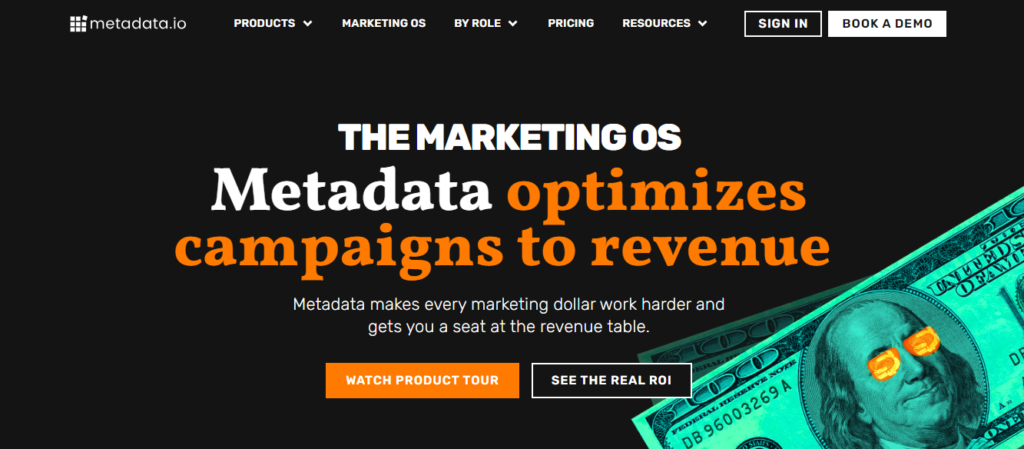
Metadata.io is an AI-powered marketing automation platform. It is designed to help businesses optimize their digital advertising campaigns. Metadata.io uses artificial intelligence to target and optimize ad campaigns across various online platforms, such as Google Ads and LinkedIn. It automates tasks like audience targeting, creative generation, and budget allocation to improve campaign performance. In summary, Metadata.io is a valuable tool for marketers seeking to streamline and enhance their digital advertising efforts using advanced AI technology.
Latest Trends and Innovations: Revolutionizing B2B Segmentation
Staying abreast of the latest trends and technological innovations is crucial in the ever-evolving field of B2B segmentation. Recent advancements, particularly in AI-driven segmentation, predictive analytics, and personalized marketing tactics, are redefining the landscape of B2B marketing.
AI-Driven Segmentation: A Game Changer
AI-driven segmentation is rapidly gaining traction, with recent statistics showing that businesses using AI for segmentation report a 30% increase in efficiency. AI algorithms can analyze vast amounts of data, uncovering patterns and segments that might be missed by traditional methods.
This technological advancement allows for real-time segmentation, constantly adapting to changing market dynamics and customer behaviors. It leads to more accurate and dynamic segmentation, significantly enhancing the relevance of marketing efforts.
Predictive Analytics: Anticipating Customer Needs
Predictive analytics is another groundbreaking trend. Businesses employing predictive analytics in their segmentation strategies have seen, on average, a 25% increase in marketing campaign response rates. This approach uses historical data and machine learning algorithms to predict future customer behaviors and preferences.
By anticipating customer needs, companies can proactively tailor their marketing strategies, ensuring they remain relevant and ahead of the curve. Predictive analytics not only improves customer targeting but also helps in forecasting market trends.
Personalized Marketing Tactics: Elevating Customer Experience
A key innovation in B2B segmentation is the shift towards highly personalized marketing tactics. Statistics reveal that businesses adopting personalized marketing see an increase of up to 20% in sales opportunities.
Personalization goes beyond basic demographic segmentation, involving customized content and communication strategies for different segments. This level of personalization enhances customer experience, leading to higher engagement and loyalty.
Incorporating these latest trends and innovations into the guide would provide readers with cutting-edge insights and practical examples of how technology is shaping the future of B2B segmentation. This will help businesses stay competitive by leveraging the most advanced tools and strategies available.
Leveraging customer segmentation tools to their full potential
We discussed customer segmentation tools, and I showed you some of the best products in this area. Let’s look at what you can do to get the most out of them.
Look for unique segmentation opportunities
When searching for ways to segment consumers, the same criteria, such as demographics, behavior, or potential order value, are often suggested. However, customer segmentation tools can expand your segmentation criteria beyond traditional methods.
These tools can help you identify unique segmentation opportunities tailored to your company. This approach can set your company apart from competitors and potentially become a critical competitive advantage in the market.
Target multiple segments with the same campaign
Consider targeting multiple segments with one campaign to save money and streamline your initiatives. Utilizing a segmentation tool to identify intersecting areas between two or more segments can increase efficiency and maximize your marketing budget.
Track the performance of your segments over time.
To effectively market to your audience, it’s crucial to segment them, send targeted ads, and track your performance over time. Keeping tabs on the effectiveness of your current marketing efforts towards each segment is crucial.
Luckily, customer segmentation tools typically come equipped with analytics features to simplify this process. Utilizing this functionality can help you identify which segments perform better than others.
Expand intra-organizational access to audience segmentation tools
It is advisable not to limit the use of marketing or sales tools to only one team member. Instead, it is more beneficial to make the technology accessible to as many people as possible. By doing so, every team in your organization can effectively utilize audience segmentation data, leading to increased profits. This approach will help you maximize the return on your investment in these tools.
Create one-of-a-kind products and services for various market niches
When it comes to boosting product sales, segment-based marketing can be highly beneficial. It’s worth considering developing new items aimed at high-value niches to expand your company’s reach. Personalization is vital in marketing, so creating a product tailored to the specific needs of one of your target markets will set you apart from competitors.
By building items that align with the goals of your different customer segments, you may even surpass your sales targets.
Don’t over-target priority segments
To achieve your sales goals, create products that align with the needs of your different customer segments. This approach can be beneficial, but it’s crucial to stay moderate. If you spend less money on just one or two segments, you might struggle to attract new customers in other areas.
This could leave you with no prospects and an empty sales funnel. That’s why allocating a portion of your marketing budget to each category is crucial.
Segmentation should extend beyond the marketing department
Most companies today use segmentation to create personalized marketing plans. Consider implementing segmentation beyond marketing and throughout your entire business. This might involve creating specialized customer service teams or modifying your sales approach. Separating customers through segmentation can give you a competitive edge and help you reach your sales goals.
Understand the differences between behavior and motivation
Companies that utilize audience segmentation technologies analyze the behavior of their segments. It’s important to note that behavior and motivation are not interchangeable. The current behavior of an audience does not necessarily indicate their future purchasing decisions. When segmenting an audience, it’s crucial to differentiate between their behavior and motivation.
Considering the total of segments can provide insight into the common thread running across them, which accurately summarizes the segment’s purchasing motivation. Targeting this common characteristic could attract more clients.
Challenges and Solutions in B2B Segmentation
B2B segmentation presents unique challenges, but with strategic solutions, these can be effectively managed. Here’s an expanded view of common challenges and practical solutions:
Challenge 1: Data Quality and Integration
Problem: One of the primary challenges in B2B segmentation is acquiring high-quality, integrated data. Disparate data sources can lead to incomplete or inaccurate segments.
Solution: Invest in robust data management systems. Regularly clean and update your data. Utilize integration tools that can consolidate data from various sources, ensuring a unified view of customer information.
Challenge 2: Dynamic Market Conditions
Problem: Market conditions in B2B environments can change rapidly, making it difficult for static segmentation models to remain relevant.
Solution: Implement agile segmentation approaches that allow for quick adjustments. Use real-time analytics and AI-driven tools to continuously update and refine your segments based on current market trends.
Challenge 3: Aligning Segments with Business Goals
Problem: Aligning segmentation with overarching business goals can be challenging, especially when there are conflicting priorities across departments.
Solution: Establish clear communication and collaboration between departments. Ensure segmentation strategies are aligned with the business’s overall objectives and KPIs. Regularly review and adjust segmentation strategies to ensure they support these goals.
Challenge 4: Over-Segmentation
Problem: Over-segmentation can lead to overly complex marketing strategies and diluted efforts, where resources are spread too thin.
Solution: Regularly assess the effectiveness of each segment. Merge or eliminate segments that do not offer significant value or ROI. Focus on segments that align closely with business objectives and have the potential for high returns.
Challenge 5: Personalization at Scale
Problem: Personalizing marketing efforts for each segment, especially in large-scale operations, can be resource-intensive and challenging.
Solution: Utilize automation and AI technologies to personalize at scale. Develop modular content strategies that can be easily adapted for different segments while maintaining a consistent brand message.
Challenge 6: Measuring Segmentation Effectiveness
Problem: Determining the effectiveness of segmentation strategies can be difficult, especially with multiple overlapping metrics and KPIs.
Solution: Focus on key performance indicators that directly reflect the success of segmentation efforts, such as conversion rates, customer acquisition costs, and customer lifetime value. Regularly review and adjust these metrics to stay aligned with business objectives.
Challenge 7: Technological Adaptation
Problem: Keeping up with technological advancements in data analytics and segmentation tools can be daunting, especially for smaller businesses.
Solution: Stay informed about the latest technologies in market segmentation. Consider partnerships or collaborations with tech firms. Prioritize investments in technology that offers the most significant impact on your segmentation strategies.
Challenge 8: Regulatory Compliance
Problem: Adhering to data privacy and protection regulations while conducting detailed segmentation is increasingly complex.
Solution: Implement stringent data governance policies. Stay updated on regional and global data protection regulations. Ensure all segmentation practices comply with legal standards, particularly regarding data collection and usage.
By addressing these challenges with strategic solutions, businesses can enhance the effectiveness of their B2B segmentation, leading to more targeted marketing efforts, improved customer relationships, and ultimately, better business outcomes.
User Personalization: Tailoring Content and Marketing Strategies
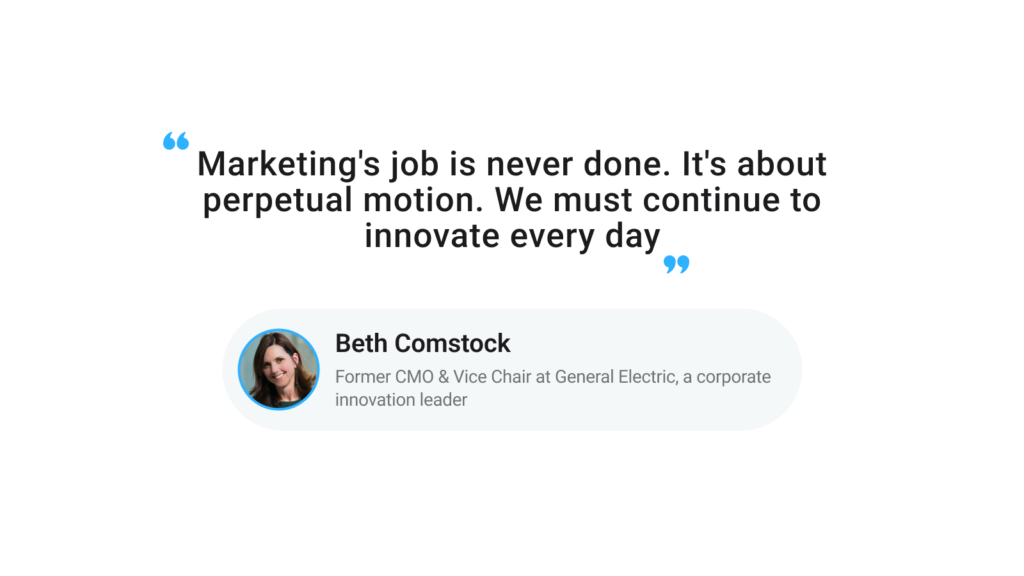
User personalization in B2B segmentation is crucial for increasing engagement and conversion rates. Here are detailed strategies and guidelines for achieving effective personalization:
Understand Your Audience Deeply
- In-Depth Customer Profiles: Build detailed profiles for each segment, encompassing not just business needs but also the motivations, preferences, and behaviors of the decision-makers within these businesses.
- Continuous Data Collection: Regularly update your understanding of each segment with ongoing data collection and analysis, including feedback, engagement metrics, and purchasing patterns.
Create Tailored Content
- Segment-Specific Messaging: Develop messaging that resonates with the specific needs, challenges, and interests of each segment. This can include customized email campaigns, targeted social media content, and tailored blog posts.
- Dynamic Content Creation: Use tools that enable dynamic content creation, where website or email content changes based on the viewer’s segment, ensuring relevancy and engagement.
Leverage Personalization Technology
- AI and Machine Learning: Implement AI-driven tools to automate and scale personalization efforts, such as predictive analytics for anticipating customer needs or AI-based content recommendation systems.
- CRM and Marketing Automation Platforms: Utilize CRM and marketing automation platforms to segment audiences and automate personalized communication, ensuring consistent and timely engagement.
Personalize the Sales Process
- Customized Sales Approaches: Train your sales team to adapt their approach based on the segment, using insights from customer profiles to address specific concerns and highlight relevant benefits.
- Segment-Specific Offers and Discounts: Create offers, discounts, or package deals that are tailored to the unique needs and preferences of different segments.
Optimize User Experience
- User Journey Customization: Customize the user journey for each segment on your digital platforms, ensuring that the navigation, content, and calls to action align with their specific interests and needs.
- Feedback Loops: Establish mechanisms for gathering and acting on customer feedback, allowing for continuous refinement of the user experience based on segment-specific preferences.
Monitor and Adjust Strategies
- Performance Tracking: Track the performance of personalized strategies using KPIs like engagement rate, conversion rate, and customer satisfaction. Use this data to continuously refine your approaches.
- Adaptive Strategies: Be ready to adapt your strategies in response to changes in customer behavior, market trends, or feedback, ensuring that personalization remains relevant and effective.
Implementation Case Studies: Real-World Applications of B2B Segmentation Strategies
Exploring how companies have implemented B2B segmentation strategies, the challenges they encountered, and the outcomes they achieved, provides invaluable insights. Here are detailed case studies illustrating this:
Case Study 1: Technology Solutions Provider
- Implementation: A leading technology solutions provider implemented a segmentation strategy focusing on industry verticals and company size. They used advanced analytics to identify unique needs within each segment and tailored their marketing messages accordingly.
- Challenges: The initial challenge was integrating data from different sources and ensuring the accuracy of segment classifications. They also faced difficulties in creating content that resonated specifically with each segment.
- Outcomes: Post-implementation, the company saw a 20% increase in lead generation and a 15% increase in customer retention rates. Their targeted approach led to more meaningful engagement with prospects and existing customers.
Case Study 2: B2B E-commerce Platform
- Implementation: This e-commerce platform for B2B transactions implemented segmentation based on purchasing behavior and business type. They personalized the shopping experience for each segment through customized product recommendations and pricing.
- Challenges: The major challenge was developing a dynamic system that could update recommendations in real-time based on user interactions. Ensuring a seamless user experience across different segments was also a hurdle.
- Outcomes: The platform experienced a 35% increase in average order value and a significant boost in user engagement. The personalized experience encouraged repeat purchases and longer session times.
Case Study 3: Manufacturing Company
- Implementation: A manufacturing company dealing with B2B clients segmented its market based on geographical location and industry application of their products. They developed region-specific marketing campaigns and adapted their product offerings to suit the unique demands of each industry.
- Challenges: The challenge was in localizing marketing efforts and ensuring that the product adaptations met the specific requirements of each industry. Managing a diverse supply chain to cater to different segments was also challenging.
- Outcomes: The company saw a 25% increase in sales in previously underperforming markets and improved customer satisfaction due to more relevant product offerings and marketing efforts.
Case Study 4: Software-as-a-Service (SaaS) Company
- Implementation: The SaaS company segmented its customers based on usage patterns and business size. They offered customized subscription plans and provided targeted customer support for each segment.
- Challenges: Tailoring the software features and support services for different segments without compromising the core product integrity was challenging. They also needed to balance resource allocation between high-usage and low-usage segments.
- Outcomes: The segmentation led to a 40% increase in customer lifetime value and a significant reduction in churn rate. Personalized support and subscription plans increased customer satisfaction and loyalty.
Case Study 5: Financial Services Firm
- Implementation: Specializing in B2B services, the firm segmented its clients based on their financial needs and investment behaviors. They developed customized financial products and advisory services for each segment.
- Challenges: The primary challenge was ensuring compliance with financial regulations while offering personalized services. They also faced the task of training their advisors to understand the nuances of each segment.
- Outcomes: The firm reported a 30% increase in client acquisition and a higher rate of successful investment outcomes for clients, attributing this success to more accurately targeted financial advice and products.
Conclusion
Identifying and engaging new clients is crucial for B2B market segmentation. By adapting marketing and sales activities to specific groups, companies can segment the total addressable market (TAM) into discrete target segments with shared features. This approach leads to better engagement, higher conversion rates, and, eventually, more significant income.
However, B2B market segmentation presents challenges like developing personal relationships for B2B products or services. Overcoming these obstacles requires a comprehensive understanding of the target audience.
Despite this, B2B market segmentation provides a robust foundation for organizations. It enables them to connect with the right consumers and deliver focused messaging, which is critical for business success. Companies can improve their understanding of the target audience and adapt their marketing tactics, resulting in long-term success provided by segmentation.
You can contact me, and I’d be happy to chat with you.
Questions You May Have
-
What is B2B segmentation, and why is it important for my business?
B2B segmentation is the process of dividing a business market into distinct groups based on common characteristics, such as industry, company size, or customer needs. It allows for more targeted and effective marketing strategies, leading to better customer engagement and improved ROI. Tools like SEMrush and BrandMentions provide insights that aid in creating precise segments.
-
How can I identify the most valuable segments for my business?
Identifying valuable segments involves analyzing customer data to determine which groups are most likely to purchase or have the highest lifetime value. Tools like Baremetrics can be used to track financial metrics that signal segment value, while Audiense offers social media insights to gauge audience engagement and potential.
-
Can B2B segmentation be automated, and what are the benefits?
B2B segmentation can be partially automated using advanced CRM and analytics tools, which streamline the segmentation process and maintain up-to-date customer profiles. Automation through platforms like ActiveCampaign ensures consistent and timely engagement with segments, allowing for scalable personalized marketing.
-
What strategies can I use to target B2B segments effectively?
Effective targeting strategies include personalized content, tailored communication, and segment-specific offers. Tools like BuzzSumo help tailor content strategies, and Survicate can capture feedback to refine targeting. Additionally, Metadata.io assists in executing targeted ad campaigns based on segment data.
-
How do I measure the success of my B2B segmentation strategy?
Success can be measured through KPIs like conversion rates, customer acquisition costs, and segment profitability. Analytical tools such as Google Analytics provide performance data, while HubSpot CRM offers comprehensive dashboards to monitor various success metrics over time.
-
What are some common challenges in B2B segmentation, and how can I overcome them?
Challenges include data integration, adapting to market changes, and personalizing at scale. Overcoming these requires a combination of the right tools and strategies. For instance, Apollo.io can integrate data for better segmentation, while SurveySparrow enables scalable personalization through feedback-driven insights.
Join my monthly newsletter
Start getting exclusive B2B marketing tips that I only share with email subscribers



![iTalki vs Preply: Which Platform Leads in 2024? [Promo codes Inside] iTalki VS Prely](https://khomichenko.com/wp-content/uploads/2023/12/image-7-770x515.png)